ISSN: 1204-5357
ISSN: 1204-5357
| GIULIANA BORELLO, PhD Post-doc fellow, University of Verona, Business Administration Department, Verona, Italy Postal Address: Via dell Artigliere, 19, 37129 Verona, Italy Email: giuliana.borello@univr.it |
| Giuliana Borello is Post-doc Fellow in Financial Markets and Institutions at the University of Verona, where she teaches Financial Markets and Institutions at graduate and undergraduate level. Her main research interests are related to banks and other financial institutions. |
| VERONICA DE CRESCENZO, PhD Assistant professor, University of Verona, Business Administration Department, Verona, Italy Postal Address: Via dell Artigliere, 19, 37129 Verona, Italy Email: veronica.decrescenzo@univr.it |
| Veronica De Crescenzo is Assistant Professor in Financial Markets and Institutions at the University of Verona, where she teaches Financial Institutions and Markets and Capital Budgeting at undergraduate level. Her main research interests are related to operational risk in banks, structure of financial markets, Central securities depositories regulation and crowdfunding. |
| FLAVIO PICHLER, PhD Associate professor, University of Verona, Business Administration Department, Verona, Italy Postal Address: Via dell’Artigliere, 19, 37129 Verona, Italy Email: flavio.pichler@univr.it |
| Flavio Pichler is Associate professor in Financial Markets and Institutions at the University of Verona, where he teaches Financial Markets and Institutions and Economics of Banking and Insurance at both undergraduate and graduate level.Research topics include theory, regulation and supervision of financial systems, economics of insurance, banking and risk management, crowdfunding. |
| © Giuliana Borello, Veronica De Crescenzo, Flavio Pichler, 2015 |
Visit for more related articles at Journal of Internet Banking and Commerce
Crowdfunding is a relatively new phenomenon. However, its growth rate in recent years has been substantial. Typically, start-ups and small and medium enterprises (SMEs) face funding problems and crowdfunding may have become an alternative funding source. We study a sample of financial return crowdfunding platforms active in the European Union. We concentrate on the organizational structure and business model of the platforms for those companies with funding needs to identify whether crowdfunding might be complementary to, or a substitute for traditional funding sources. The analysis evidences an extreme heterogeneity among platforms, partly due to the lack of regulation at both national and European level. Furthermore, it shows that crowdfunding has evolved from pure p2p to p2b and b2b fundraising, even in equity crowdfunding where target companies are mainly represented by start-ups. Also, some characteristics of p2p lending and equity platforms are significant for the future development of crowdfunding as an alternative source of capital. Another critical issue which may impact upon the future development of crowdfunding is regulation. Crowdfunding is largely still an unregulated activity. The ways in which crowdfunding is regulated will seriously affect its capacity to reduce the funding gap for start-ups and SMEs.
Keywords |
| Financial return crowdfunding, Funding gap, Startup, Small and medium sized enterprises, European crowdfunding platforms |
INTRODUCTION |
| Crowdfunding is a new funding practice through which people, often living in different geographical areas, contribute to funding a project they share an interest in. Money is raised via online platforms, thus, utilizing the Web 2.0 technologies. Crowdfunding is a relatively new phenomenon. However, its growth rate in recent years has been substantial. The European Commission (2014) has recorded that crowdfunding platforms raised €445m in 2011, €735m in 2012, and €1bn in 2013. The exact factors leading to the rise in crowdfunding are still unknown; yet, the credit crunch, which occurred after the financial crisis and Web 2.0 technology, can be seen as two driving factors (Kirby & Worner, 2014, p. 21). |
| Typically, start-ups and small and medium enterprises (SMEs) face funding problems and crowdfunding may have become an alternative funding source. Existing crowdfunding platforms exhibit very heterogeneous organizational structures and perform many functions. These dissimilarities hinder the creation of publicly available databases, which in turn impedes a deeper understanding of the phenomenon. |
| We study a sample of financial return crowdfunding platforms active in the European Union. We concentrate on the organizational structure and business model of the platforms for those companies with funding needs to identify whether crowdfunding might be complementary to, or a substitute for traditional funding sources. |
| The paper is organized as follows: Section 2 provides a detailed definition and a classification of crowdfunding, Section 3 contains the literature review, Section 4 presents the methodology for the study, Sections 5 and 6 discuss the results of the analysis, and Section 7 proposes the main conclusions and policy implications. |
DEFINITION OF CROWDFUNDING TYPES AND BUSINESS MODELS |
| Crowdfunding originates from crowdsourcing, that is, the process of contributing to the creation and fulfillment of a new business idea (Poetz & Schreier, 2012). Crowdfunding refers to circumstances whereby many people give typically small amounts of money to projects and ideas via online platforms. However, this broad definition misses individual crowdfunding, which is when ideas and projects are funded directly and not via online platforms. Valanciene and Jegeleviciute (2013) propose an overview of the different definitions of crowdfunding that can be found in the literature. The following features are essential: (i) a business idea/project that requires funding; (ii) many investors, or backers, willing to contribute to the realization of that business. Backers should be mainly, or in some cases exclusively, non-professional investors; and (iii) the online platform should connect backers and entrepreneurs. |
| According to Cumming, Leboeuf, and Schwienbacher (2014, p. 3), fundraising can take place in two ways, either “All or Nothing” or “Keep it All”. In the former situation, the company or individual seeking funds sets a target funding goal. If it is not reached, then the applicants will not keep the money. In the latter case, the company or individual is allowed to keep all the funds that were raised, even when the target funding goal is not reached. |
| Kirby and Worner (2014) suggest that crowdfunding models can be classified as community crowdfunding or financial return crowdfunding, which differ regarding the presence of a return of backers or not. Community crowdfunding includes social lending/donation crowdfunding and reward crowdfunding, while financial return crowdfunding refers to peer-to-peer (p2p) lending and equity crowdfunding (Figure 1). |
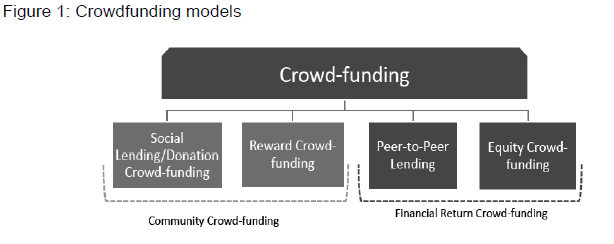 |
| Investors in both types of community crowdfunding platforms have similar motivations, i.e. a sense of belonging, ethics in investing, moral awareness. The prospect of a financial return is not an essential condition for investing in the projects using community crowdfunding platforms. However, backers may expect to receive a non-financial return, which in turn may give rise to specific types of crowdfunding, namely sponsoring, preselling/ pre-ordering and rewards (European Commission, 2014, pp. 3–4). Agrawal, Catalini, and Goldfarb (2011) contest the inclusion of reward crowdfunding into the community crowdfunding category. They suggest that backers for reward crowdfunding initiatives share the same expectations with financial return crowdfunding investors, since they both await the funding process to be successful. |
| Financial return crowdfunding includes p2p lending and equity crowdfunding platforms, where investors give money in the form of debt or equity, wishing to receive a financial return, which is interest and principal or dividend, respectively. Belleflamme, Lambert, and Schwienbacher (2014) suggest that profit-sharing platforms, where backers participate in the profits of the funded initiative, may be grouped together with equity crowdfunding platforms. |
FEATURES OF FINANCIAL RETURN CROWDFUNDING PLATFORMS |
| Based on the characteristics identified thus far, financial return crowdfunding platforms can be seen to play a major role in reducing the funding gap evidenced by start-ups and SMEs. Financial return crowdfunding can be seen as providing an alternative funding source to traditional forms of capital. The specific characteristics of these alternative funding practices should be identified. In p2p lending platforms, lenders give money to borrowers, becoming creditors of the companies requesting funding online. In performing this activity, p2p lending platforms may play several roles, which cannot be narrowed down to a precise set of functions performed in the funding process. These dissimilarities in the functions performed by p2p lending platforms stem from the lack of any agreed rules for p2p lending at both the national and regional, European level (European Crowdfunding Network, 2013a; 2013b) and strongly limit an analysis of the phenomenon. |
| Kirby and Worner (2014, pp. 16–19) classify the business models of p2p lending platforms into three categories: the client segregated account model, notary model, and guaranteed return model, where the role of the platform is considerably expanded. |
| In the client segregated account model, platforms play a very limited role, almost exclusively matching borrowers’ funding needs to lenders’ funding disposals. Money collected is then kept in a bank account separate from that of the platform. The platform has no right to access this bank account. The notary model provides the platform with a larger role. It matches funding and investment requests and collects money, which is then transferred to the bank. The bank originates the loan and the platform issues a note to the lender reflecting the amount of money that has been given to the borrower. Finally, in the guaranteed return model, the platform matches requests, defines the terms and conditions for the loan, and sets a guaranteed return rate for the investors. In this model, the platform issues the loan to the borrowers directly. |
| Two critical aspects must be evidenced with respect to the credit as well as the liquidity risk mitigation process put in place by p2p lending platforms. On one hand, it should be investigated whether platforms select and evaluate projects before they are approved for online funding. These processes are essential in mitigating credit risk both before and after the loan has been issued. Therefore, it is of critical importance to analyze the role played by the platform in assessing projects before uploading them (ex-ante screening) and in providing adequate information during the life of the loan (ex-post monitoring). On the other hand, platforms may provide investors with the ability to sell their loans to other lenders before the loans have reached maturity, which reduces liquidity risk (secondary market). |
| Investors in equity crowdfunding platforms buy shares in the companies, which propose their business idea or project online, thus, becoming shareholders of the companies. Equity crowdfunding is an alternative funding source for smaller companies and for those in the seed as well as start-up stage (Wilson & Testoni, 2014; Deffains-Crapsky & Sudolska, 2014). Venture capital and private equity funds are not adequately fulfilling their role in backing companies in their early development stages, which makes it difficult for companies wishing to implement their business ideas to enter and be active in the market. Therefore, it is important to investigate whether equity crowdfunding is able to reduce this funding gap and to consider the functions that equity platforms should accomplish. |
| A critical issue regarding equity crowdfunding relates to the risks it poses for investors, which are deemed higher than those of p2p lending. For this reason, and in contrast to p2p lending, equity crowdfunding has been the subject of ad hoc regulation. This is particularly the case in the United States (US) and Italy and the United Kingdom (UK) within the European Union. Regulation can have a strong impact upon the organizational structures and business models of equity crowdfunding platforms. It can also influence the potential of these platforms to provide an alternative source of capital to start-ups and SMEs. |
| In particular, investor protection regulation may be invoked to limit investments on equity crowdfunding platforms to professional clients, to investors with specific competences, and to high net worth individuals (HNWIs). Such a strict regulation could reduce the number of possible investors giving money to business projects and ideas via online platforms. Moreover, as Pierrakis and Collins (2013) suggest, regulation could be deemed as inconsistent with the fundamental principle of crowdfunding, which is the monetary contribution (if even very small) of the crowd, to the funding of projects and ideas via the internet. This crowd is mainly comprised of non-professional investors wishing to contribute to the realization of a business idea that they believe in. |
LITERATURE REVIEW |
| Crowdfunding is a new phenomenon that has only recently received attention in the literature. The existing literature on crowdfunding can broadly be separated into two categories based on their methodological approach, theoretical or empirical. |
| In the theoretical category, the only contribution known to the authors is that of Belleflamme et al. (2014), who investigate the economic factors behind the decision of an entrepreneur to turn to crowdfunding to raise money for her business idea or project. Belleflamme et al. show that entrepreneurs prefer pre-ordering crowdfunding in case they need relatively small amounts of money, while they turn to profit sharing crowdfunding if the funding need is much bigger. |
| In the empirical category we group those contributions that use an econometric model with the aim of investigating the determinants of crowdfunding. However, it should be noted that the main limitation concerning the empirical stream of literature on crowdfunding relates to the availability of public data on the projects seeking funds. With this caveat in mind, we further divide this stream of literature according to the data used in the analysis. We then review papers using data on individual crowdfunding practices—the do it yourself (DIY) practice—which is when there is no crowdfunding platform to match investors and entrepreneurs, and papers that employ data on projects available on specific crowdfunding platforms. |
| Belleflamme et al. (2013) study the DIY projects identified through the internet to discover which characteristics and factors determine their success. They suggest that individual crowdfunding projects and ideas can be highly customized. This is proposed as the rationale for choosing DIY crowdfunding rather than crowdfunding handled through an online platform. The authors show that in the case of DIY projects, not-forprofit projects and ideas are those with the highest probability of success. |
| There are three significant contributions in the literature investigating traditional forms of crowdfunding, that is, those that occur via online platforms. Agrawal et al. (2011) concentrate on projects available on Sellaband, a Dutch platform providing both reward and profit-sharing crowdfunding. The authors investigate whether the geographical distance between the investors and the entrepreneurs plays a role in the investment decision. Their results suggest that investors back the projects they like irrespective of the geographical location of the entrepreneur. |
| Mollick (2014) also analyzes a reward crowdfunding platform, Kickstarter, which based in the US. The aim of the paper is to test which characteristics of the projects raising funds are most likely to determine their success or failure. The key characteristics expected to determine the project’s outcomes are: the quality of the project, the role of social networks, and geography. The analysis shows that funded projects are usually those with the greatest attention to communication (quality of the project), those whereby the entrepreneurs have a high number of friends on the social networks (importance of social networks), and those that reveal the closest relationship between the business idea and the socio-economic and cultural context in which it will come into existence. |
| Indiegogo is a reward crowdfunding platform also based in the US that was analyzed by Cumming et al. (2014). They investigate whether the chosen funding model (all or nothing or keep it all) depends on the type of company seeking funds. They find that the all or nothing model is chosen by firms that wish to signal to investors the importance of asking for realistic funding. In other words, they are not going to start their business if they do not collect all the money needed. In contrast, the keep it all model is preferred by companies whose project can be implemented even if the target funding is not fully reached, that is, the project can be scaled. |
| There is a lack of analysis on projects available for funding on financial return crowdfunding platforms. Such an assessment is essential if we consider that crowdfunding is becoming an alternative to business angels and venture capital for startups and SMEs, as suggested by Tomczak and Brem (2013). Literature on the role of entrepreneurial finance in reducing the funding gap (Cosh, Cumming, & Hughes, 2009; Lam, 2010) as well as on the determinants and features of funding provided by venture capitalists and business angels to companies in either the seed or start-up stages (Barry, 1994; Lerner, 1995; Kaplan & Stromberg, 2001; Hsu, 2004) is extensive. However, it will not be reviewed here. |
| Regarding the role of financial return crowdfunding in reducing a funding gap, the literature is still at the embryonic stage. The contribution by Mach, Carter, and Slattery (2014) deserves mentioning. They investigate the business ideas of SMEs seeking funds on a p2p lending platform based in the US, Lending Club. The authors discuss the characteristics of the initiatives and the interest rate paid by the borrowers. The results suggest that projects proposed by SMEs are more likely to be funded. However, the interest rate for SME projects is higher than that of initiatives whose entrepreneur is not a SME by one percent. |
| Finally, in p2p lending crowdfunding, another important determinant of investors choosing which project to give money to is considering what other investors do (herding behavior). This is studied by Zhang and Liu (2012) based on data on initiatives available for funding on the US p2p lending platform, Prosper. They suggest that rational herding is when the activity of other lenders seems much more important than the objective characteristics of the entrepreneur. |
SAMPLE SELECTION PROCESS |
| Based on the literature presented so far, we recognize that crowdfunding could play a major role in funding new business ideas and initiatives as an alternative source of capital. Our paper aims to identify those features within active European financial return crowdfunding that boost investors’ participation in the process of funding start-ups and SMEs via online platforms. We acknowledge that big differences in organizational structures and business models exist across platforms. |
| Acknowledging the lack of a complete database on European crowdfunding platforms because of its diverse nature, we relied on different websites offering a collection of platforms to create our sample. In particular, we included the p2p lending and equity crowdfunding platforms with legal residence within the European Union listed on www.thecrowdcafe.com and www.crowdsourcing.org for the period April–October 2014. For p2p lending only, we also included platforms scheduled by www.wiseclerk.com. Moreover, being aware that crowdfunding in Italy is regulated by the Consob Regulation no. 18592 of 26 June 2013, where portal managers are asked to register on the Register of portal managers for the collection of innovative startup capital through on-line portals, we included the registered Italian equity crowdfunding platforms. |
| Our initial sample is made up of 119 financial return crowdfunding platforms comprised of 52 p2p lending and 67 equity crowdfunding platforms. |
| At this stage, we divide this original sample into two subsamples, one including p2p lending platforms and one containing equity crowdfunding platforms. From both subsamples we exclude platforms: |
| • that are non-active at the time of writing, which means, in other words, those that provide no investment opportunities |
| • whose website has no English section, nor information in English if the link for the English language is active. We decide to exclude these platforms to avoid influencing our dataset with information for which translation is a critical issue. Linguistic and regulatory homogeneity between entrepreneurs and investors, that reflect geographical proximity, seems a critical feature of European crowdfunding |
| • whose activity is not coherent with p2p lending and equity investing. |
| Regarding the p2p lending subsample, we exclude five non-active platforms, 17 portals which do not give any information in English and six platforms that perform microcredit activity. The final p2p lending subsample is then made up of 24 platforms (see Table 1). |
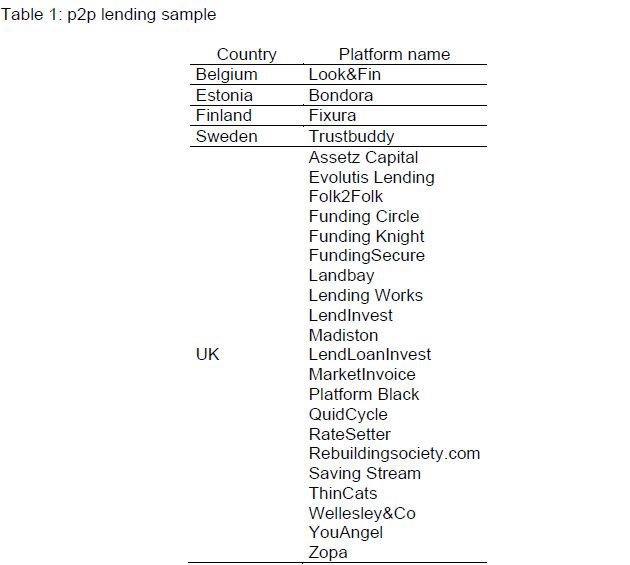 |
| The UK is most represented in our p2p lending subsample with 20 platforms. This may be due to the exclusion of those platforms not providing information in English. The three other countries we are considering are Belgium, Estonia, Finland, and Sweden. |
| From the equity crowdfunding subsample we exclude 17 non-active portals, 25 platforms that provide no information in English, and four real estate platforms. Our final subsample of equity crowdfunding platforms consists of 21 platforms, as shown in Table 2. |
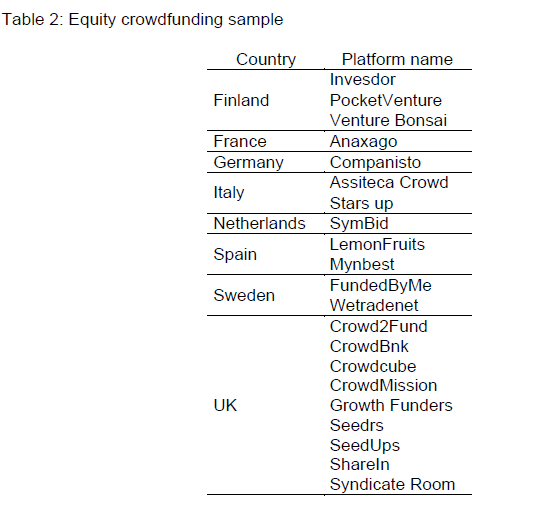 |
| Table 2 shows also shows that the UK is highly represented in our subsample (nine platforms). Other platforms come from Finland (three), Italy, Spain and Sweden (two platforms each), France, Germany, and the Netherlands (one platform each). |
METHODOLOGY |
| Identification of the key features of p2p lending and equity crowdfunding platforms is an important step in understanding which characteristics can foster this alternative funding source and consequently reduce the funding gap typically facing start-ups and SMEs. To implement our analysis, we identified six sets of relevant variables reflecting the characteristics of the platforms and of the counterparties. The characteristics of the platforms contain common variables as well as specific variables relating exclusively to p2p lending or to equity crowdfunding platforms. The counterparties are borrowers and lenders in p2p lending while they are target companies and investors in equity crowdfunding. |
| The variables used in the analysis are presented in Tables 3 and 4. |
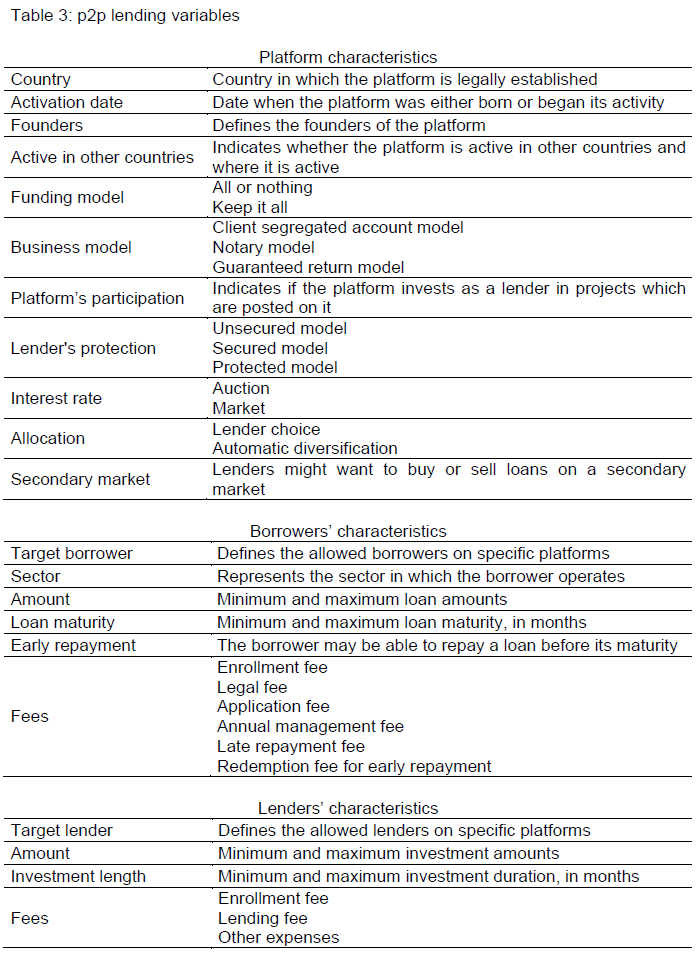 |
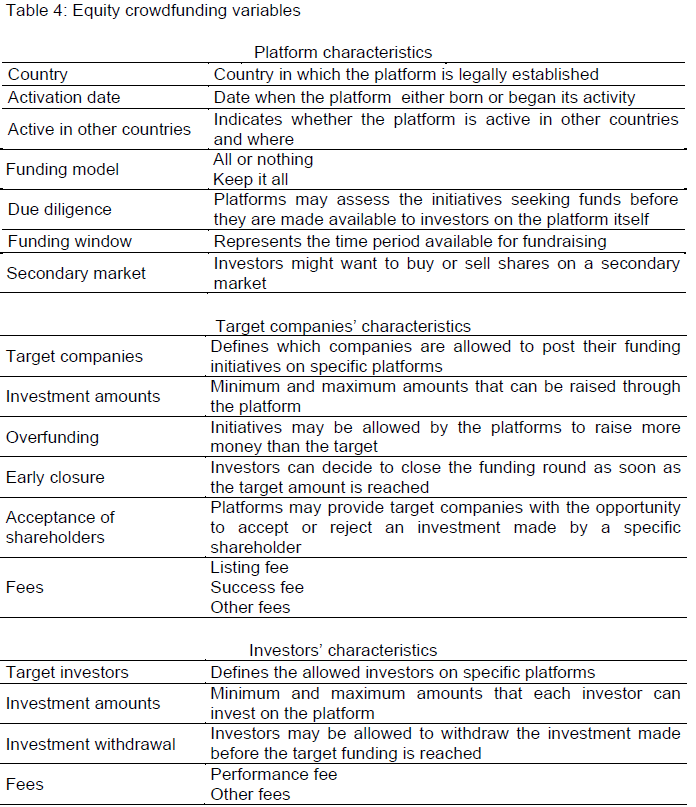 |
| After identifying the subsamples and the variables of interest, the information was retrieved from the platforms’ websites. In particular, we looked at those sections explaining how the platform works, frequently asked questions, and terms and conditions. |
ANALYSIS OF P2P LENDING PLATFORMS |
| We now present the results of our analysis on the characteristics relating to platforms, borrowers, and lenders. |
CHARACTERISTICS OF P2P LENDING PLATFORMS |
| The first variable of interest is the birth date of the platform, which can either be the date it was founded or the date in which it commenced operations. The analysis of our sample shows that the p2p lending crowdfunding phenomenon was born in the UK, where the first p2p lending platform, Zopa, was created in 2005. However, recently the number of p2p lending platforms has significantly increased throughout Europe (Figure 2). |
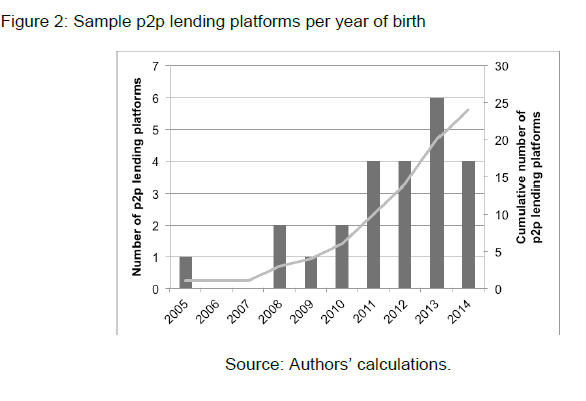 |
| Figure 2 displays the number of p2p lending platforms in our sample corresponding to their year of birth, and the cumulative number of platforms (right scale). The increase in the number of p2p lending platforms since 2011 is driven by the rise in the number of UK-based platforms. The sample selection criteria of platforms in the English language might have negatively influenced this analysis since it has geographically restricted the sample mainly to the UK. |
| Sixteen out of the 24 sample p2p lending platforms were founded by individuals, mainly from financial or IT backgrounds. Only eight platforms were established by firms, two of which are of a financial background. |
| The variable that proxies the internationalization of the platforms’ activity reveals mainly a domestic interest. Only four sample p2p lending platforms accept either foreign borrowers or lenders. In other words, only 17 percent of European p2p lending platforms function on an international level, which is supposed to characterize the crowdfunding phenomenon. |
| Regarding the funding model, 58 percent of the platforms opt for the all or nothing operating mode, while five platforms adopt the keep it all approach. The remaining platforms do not supply this information. |
| Another key variable in our analysis is represented by the business model. In particular, the vast majority of European p2p lending platforms (20) adopt a client segregated model. Three platforms choose the notary model and play a central role in issuing the notes to lenders, while only one European p2p lending platform guarantees lenders a minimum return, thus, implementing a guaranteed return model. The only platform that participates in the funding of its borrowers is Wellesley&Co. |
| The p2p lending activity is characterized by the emergence of credit risk on the part of borrowers. Therefore, it is important to evaluate what guarantees the platforms supply to the lenders. In particular, borrowers might be asked to give real or personal guarantees (secured model), or platforms could establish a fund for which lenders could apply if the borrower is insolvent (protected model), or they may not establish any guarantees for lenders (unsecured model). Our analysis shows that there is an equal distribution of these models among European p2p lending platforms. Moreover, the adoption of a protected model is a recent development. |
| The interest rate is determined either through an auction or by the platform. If through auction, both borrowers and lenders participate in a competitive bidding process. If the platform determines the interest rate, it is set depending on both market information and borrower’s specific credit risk. In our sample, 15 p2p lending platforms determine the interest rate through an auction, while two give participants the opportunity to choose which way to set it. |
| Allocation of investments can be automatic, where the platform itself matches borrowers’ and lenders’ requests, thus, diversifying the lender’s portfolio. Lenders can also choose which initiatives to back. Forty-two percent of p2p lending platform sample prefer the latter allocation, while six platforms use automatic diversification. Eight platforms allow lenders to choose between automatic diversification and lender choice. |
| The role of the secondary market is relevant in reducing credit and liquidity risk as well as in fostering investments. Seven European p2p lending platforms establish a secondary market where lenders can sell their credits before they come to maturity. |
| The last relevant variable in our analysis is the length of the funding window, which is typically 30 days. |
BORROWERS’ CHARACTERISTICS |
| Analyzing borrowers’ characteristics is a necessary step towards understanding which initiatives can be funded through p2p lending. |
| Our sample consists of ten platforms that provide funding exclusively to individuals’ business ideas, nine platforms that provide crowdfunding for companies only, and five platforms accepting projects from both individuals and companies. Since 2011, crowdfunding for companies has significantly grown, particularly in the UK. |
| The minimum and maximum amounts of funding set for the borrowers depend on whether the platform accepts individuals and/or companies’ initiatives for crowdfunding. For individuals, the minimum amount is €100–€2,000, while the maximum amount is €75,000–€6.3 million. For companies, the minimum range is €2,500–€63,000 and the maximum range is €190,000–€3.8 million. |
| For the majority of the European p2p lending platforms, the funding has a minimum duration of 1–12 months and a maximum duration of 5 years. The opportunity for the borrower to have the loan reimbursed before the loan reaches maturity is popular among p2p lending platforms (87 percent), 11 of which allow for prepayment without penalties. |
| Fees for borrowers are diverse and platforms update them continuously. The main fees are: |
| • The application fee. This fee is charged to cover some of the costs involved in processing the funding. The application fee is determined either as a percentage of the required amount of the loan or as a fixed amount. Sixteen p2p lending platforms charge this fee when borrowers apply for the loan. |
| • Annual management fee. This fee is usually calculated as a percentage of the borrowed amount and it is aimed at covering the administrative costs of the platforms. Twelve platforms charge this fee. |
| • Late repayment fee. Eleven platforms use this fee to penalize those borrowers that delay the loan interest payments. |
| • Enrollment fee. Eight platforms allow borrowers to advertise their business idea only if they have previously registered with this fee. |
LENDERS’ CHARACTERISTICS |
| The final part of our analysis on p2p lending platforms relates to lenders’ characteristics. In the majority of the platforms in the sample, backers can be either individuals or companies (15 out of 24). Five platforms allow investments only by individuals and two only by companies. Two remaining platforms focus on invoice finance and pursue professional investors only. |
| Sixty-three percent of the sample of p2p lending platforms do not allow for a maximum amount. On the contrary, the minimum investment varies in the range from €7–€63,000. Most platforms in the sample have different funding windows for the borrowers and lenders. This may be due to the presence of the secondary market or due to automatic diversification. On the other hand, nine platforms have the same funding windows for borrowers and lenders. |
| In over half of the sample of p2p lending platforms, fees for lenders are not requested. However, when the platforms request lenders to pay fees, these are lower than those for the borrowers. Lenders are usually charged for registering on the platforms (seven out of 24 platforms), as well as a percentage of the investments they make, i.e. the lending fee (five platforms). |
ANALYSIS OF EQUITY CROWDFUNDING PLATFORMS |
| In the following sections, we present the results from the analysis of the characteristics of equity crowdfunding platforms, target companies, and investors. The equity crowdfunding platforms in the sample share the all or nothing funding model. Equity crowdfunding activity is more recent than p2p lending. The first European platform began only in 2009. However, the number of equity crowdfunding platforms has significantly increased in 2012 and 2013 (Figure 3). |
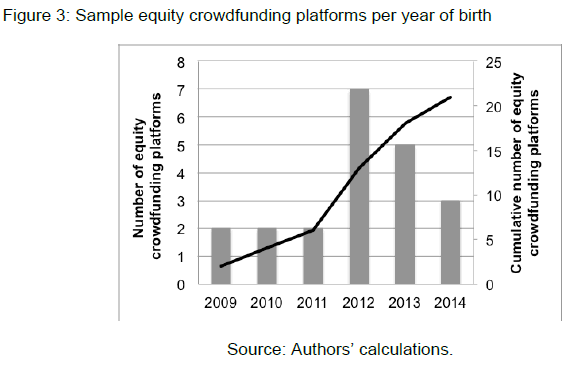 |
| We consider the cross-border aspect of equity crowdfunding by investigating whether the target companies and/or investors are expected to have legal residence in the home country of the platform. Regarding the target companies, only eight platforms accept target companies from outside their own country of origin; these platforms operate in Finland, Germany, Spain, and Sweden. Target companies residing outside Europe can only access three out of these eight portals, while five direct their attention exclusively to European companies. Regarding investors, six platforms from Germany, the Netherlands, Spain, Sweden, and the UK accept investors from outside their home country. |
| An important feature of equity crowdfunding is that due diligence is performed to evaluate the project before it attracts funding. This is an attempt to protect investors, particularly in the case of start-ups, who are typically non-professional investors. Due diligence can be done either before or after the project reaches the funding target. If it is done after, the platform may decide to leave the first assessment of the project to investors. If the project is not fully funded, there will be no reason to conduct due diligence. Moreover, due diligence can be performed directly by the platforms or by external professionals. In our sample, 76 percent of equity crowdfunding platforms carry out due diligence directly, usually before the initiative is posted on the portal and open for funding. However, several platforms focusing on start-ups conduct no due diligence or simply perform a formal check of the documents provided by the company seeking funds. |
| The funding window for equity crowdfunding is short—between 15 and 120 days. Two platforms explicitly extend this period to six and 12 months. |
| Finally, the investigation of the equity crowdfunding platforms in Europe shows the presence of the secondary market as a backstop against liquidity risk. Our survey reveals that very few platforms (three out of 21) created a secondary market for their investors to sell shares previously bought on that same equity crowdfunding portal. |
CHARACTERISTICS OF TARGET COMPANIES |
| Start-ups are the target company for the vast majority of European equity crowdfunding platforms (62 percent of the portals in the sample). Neither the size of the firm, nor its sector appears significant to platforms’ accepting business ideas seeking equity capital. Yet, target companies looking for money on Italian equity crowdfunding platforms must be start-ups. |
| Regarding the minimum and maximum investment required, not all platforms set boundaries due to the European rules on promotion or offer of financial instruments. However, the Italian legislation imposes a minimum five percent investment from a professional investor. Our analysis does not evidence a specific relationship between target companies and the minimum/maximum limits cited above. |
| Several platforms differentiate between public and private rounds, depending on the funding amount requested by the company. Private rounds are used when there are high funding needs, whereby portals do not disclose some of the information on the project or business idea. The target company can then decide to disclose more detailed information only to those investors who are deemed appropriate for the investment. |
| Forty-three percent of platforms in the sample give target companies the opportunity to raise more funds that the target amount (overfunding). Moreover, in 52 percent of equity crowdfunding portals the funding round can be shorter than the available funding window if the target company raises all the money. In contrast, few platforms (three) allow target companies to reject undesired investors. |
| The success fee is the most by equity crowdfunding platforms. It is paid by the companies seeking funds once the target amount is reached. Sixty-seven percent of platforms in the sample determine the success fee as a percentage of the raised amount. On the other hand, the listing fee, that is, the fee for the investors to post their project online, is less often used (four platforms) and is typically calculated as a fixed amount. Finally, other fees are needed to cover operating costs and legal expenses. |
INVESTORS’ CHARACTERISTICS |
| The most relevant variable relating to investors’ characteristics is the type of client that the platforms accept for investment. In other words, it is important to investigate whether equity investment is exclusively addressed to specific investors’ categories. In our sample, six UK platforms accept only professional or sophisticated investors and HNWIs. |
| The minimum investment on platforms accepting all categories of investors is €5–€100, while portals that address professional or sophisticated investors and HNWIs require a higher minimum investment (£500–£1,000). Equity crowdfunding platforms do not usually set a maximum investment amount. However, one platform in our sample has an annual limit on investments per investor, which depends on the experience of the investor and on returns gained on previous investments. |
| Equity crowdfunding platforms operate on an all or nothing model, thereby allowing investors to withdraw their investment before the target amount is reached or before money is transferred to the target company. |
| The last variable of interest to the analysis is fees paid by investors. Twenty-nine percent of European crowdfunding platforms prefer to charge the target companies rather than investors. In the case where portals request money from investors, the fees cover the administrative burden of the platform itself, as well as the costs of gaining access to the secondary market of that specific portal. Finally, another important fee is the performance fee, which is determined as a percentage of the gains on the investment. |
DISCUSSION |
| From a theoretical perspective, crowdfunding can facilitate the fundraising activities of start-ups and SMEs. The main reason for this is that investments can reach a greater number of lenders from outside the country of origin of the firm/individual seeking funds. Moreover, the requested minimum investment is quite small, which in turn favors portfolio diversification and allows for risk reduction. These features may reduce the formation of asymmetric information that typically arises between counterparts. |
| Contrary to our expectations, our analysis reveals that of the few platforms performing cross-border activity, it is mainly the equity ones doing so. This means that platforms rarely accept investments or fundraising initiatives from individuals or companies residing outside the countries the platforms are based in. Further, a limited number of European platforms detail information pertaining to their business in the English language, thus, showing a preference for domestic activity. |
| The absence of any agreed regulation on financial return crowdfunding both at a national and European level might have caused the lack of internationalization. It could have fostered the sustained growth of crowdfunding. On the other hand, it could have impeded its full development because of scarce investor protection. However, differences in regulation and supervision between European countries could give rise to regulatory arbitrage on the part of platforms, as well as cast doubts over which law should govern international transactions. The case of regulatory arbitrage may be due to differences between countries regarding investor protections. Thus, the European Commission (2014, pp. 7–8) stated that dissimilarities in regulation across European countries should be avoided to safeguard the growth of crowdfunding. In addition, Belleflamme and Lambert (2014) highlight that a regulation focusing only on fundraising activity should consider two other key features of crowdfunding: (1) the potential to reduce marketing costs; and (2) the potential to receive feedback from the market. Finally, it should be noted that the commitment for an institutional investor, as required by Italian regulations on crowdfunding, is still difficult to assess. |
CONCLUSION |
| Crowdfunding is a new and still evolving phenomenon, which is dependent on the Web 2.0 technology. Modeling those factors that have fostered its emergence and growth as well as its characteristics is challenging. However, this study presents a necessary step towards a deeper understanding of the role that a specific model of crowdfunding, namely financial return crowdfunding, may play as a funding source for start-ups and SMEs. |
| Our analysis of European financial return crowdfunding platforms shows that it was born in the UK and is typically a market-based financial system. Further, the creation of the vast majority of European portals overlaps with the recent financial crisis and credit crunch. Another key finding is that crowdfunding has evolved from pure p2p to p2b and b2b fundraising, even in equity crowdfunding where target companies are mainly represented by start-ups. |
| Our research also shows that some characteristics of p2p lending and equity platforms are significant for the future development of crowdfunding as an alternative source of capital. In particular, the presence of a secondary market and the absence of any precise identification of the target sectors should favor fundraising. However, the trading of either loans or shares on the secondary market is little used by European platforms. In the case of p2p lending platforms, the adoption of a protected model that safeguards lenders in the case of borrower’s insolvency, and the opportunity for early repayment provided to borrowers are two important features. Two important features of equity crowdfunding are due diligence, performed by many platforms before posting the project online, and the engagement of specific categories of investors. |
| We appreciate that our research has a significant limitation due to the fact that our sample selection process excluded those financial return crowdfunding platforms that did not provide any information in English. This may have influenced the analysis because our results could have overestimated or underestimated the presence and/or lack of specific characteristics. |
| Another critical issue which may impact upon the future development of crowdfunding is regulation. Crowdfunding is largely still an unregulated activity. The ways in which crowdfunding is regulated will seriously affect its capacity to reduce the funding gap for start-ups and SMEs. |
| Further research is needed on the role of financial return crowdfunding. In particular, the whole spectrum of European financial crowdfunding platforms must be considered, independently of the language in which the platforms provide information relating to their activity. Research should also critically evaluate regulatory frameworks at both the domestic and European level. |
References |
|
Copyright © 2026 Research and Reviews, All Rights Reserved